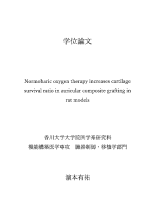Normobaric oxygen therapy increases cartilage survival ratio in auricular composite grafting in rat models
この論文にアクセスする
著者
書誌事項
- タイトル
-
Normobaric oxygen therapy increases cartilage survival ratio in auricular composite grafting in rat models
- 著者名
-
濵本, 有祐
- 学位授与大学
-
香川大学
- 取得学位
-
博士(医学)
- 学位授与番号
-
甲第703号
- 学位授与年月日
-
2018-12-26
注記・抄録
PurposeThis study aims to clarify whether normobaric oxygen therapy improves the survival of auricular composite grafts in rats.
MethodsFor 10 male SD rats, 1.5 cm2 composite grafts were harvested from bilateral ear regions including whole auricles. The harvested grafts were transferred caudally and sutured there. The 10 rats were randomly divided into two groups and kept for 21 days in two different circumstances. The first group (Control group: five rats carrying 10 grafts) was kept in room air (20% oxygen) throughout the 21 days, and the second group―named NBO (normobaric oxygen) group (five rats carrying 10 grafts)―was kept in normobaric 60% oxygen for 3 days and then in room air for 18 days. All the 10 rats were sacrificed on the 21st day. Surviving areas of the grafts and the height of the surviving auricular cartilage were examined for statistical comparison of the two groups. Furthermore, the conditions of chondrogenesis occurring around the perichondrium were compared between the two groups.
ResultsSurviving areas did not present statistically significant differences between the two groups. The height of surviving cartilage was significantly greater for the NBO group (2610 ± 170 SD µm) than that for the Control group (1720 ± 190 SD µm). Chondrogenesis occurred at positions more distant from the recipient bed in the NBO group than that in the Control group.
ConclusionNormobaric oxygen therapy increases the thickness of surviving cartilage in auricular composite grafting in rats, thus suggesting that NBO therapy may also be effective in composite grafting for humans.
Purpose This study aims to clarify whether normobaric oxygen therapy improves the survival of auricular composite grafts in rats.
Methods For 10 male SD rats, 1.5 cm2 composite grafts were harvested from bilateral ear regions including whole auricles. The harvested grafts were transferred caudally and sutured there. The 10 rats were randomly divided into two groups and kept for 21 days in two different circumstances. The first group (Control group: five rats carrying 10 grafts) was kept in room air (20% oxygen) throughout the 21 days, and the second group―named NBO (normobaric oxygen) group (five rats carrying 10 grafts)―was kept in normobaric 60% oxygen for 3 days and then in room air for 18 days. All the 10 rats were sacrificed on the 21st day. Surviving areas of the grafts and the height of the surviving auricular cartilage were examined for statistical comparison of the two groups. Furthermore, the conditions of chondrogenesis occurring around the perichondrium were compared between the two groups.
Results Surviving areas did not present statistically significant differences between the two groups. The height of surviving cartilage was significantly greater for the NBO group (2610 ± 170 SD µm) than that for the Control group (1720 ± 190 SD µm). Chondrogenesis occurred at positions more distant from the recipient bed in the NBO group than that in the Control group.
Conclusion Normobaric oxygen therapy increases the thickness of surviving cartilage in auricular composite grafting in rats, thus suggesting that NBO therapy may also be effective in composite grafting for humans.

